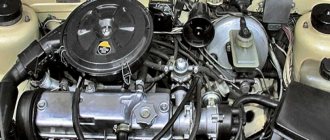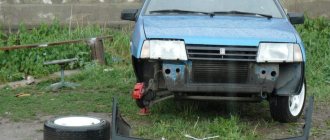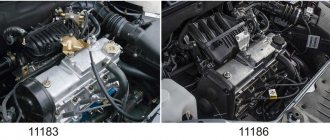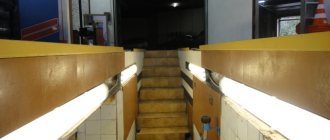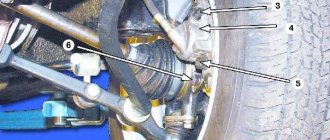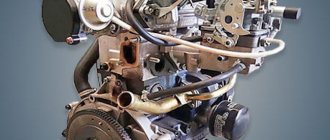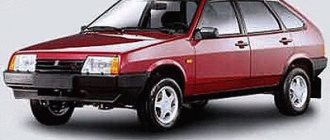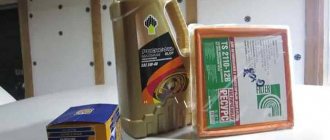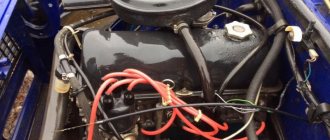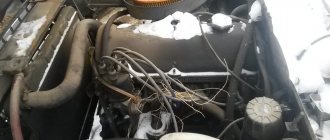Dismantling and assembling the piston with connecting rod VAZ 2108, VAZ 2109, VAZ 21099, Lada Samara
Piston with connecting rod:
1 –
connecting rod bolt nut
2 –
connecting rod bearings
3 –
connecting rod
4 –
piston pin
5 –
upper compression ring
6 –
lower compression ring groove
7 –
oil scraper ring groove
8 –
piston
9 –
connecting rod bolt
10 –
connecting rod cap
For the convenience of selecting pistons by cylinder, cylinders and pistons, depending on the diameter, are divided into five size groups: A, B, C, D, E. Pistons of nominal sizes of three classes are supplied as spare parts: A, C, E and two repair sizes. The first repair size is increased by 0.4 mm, the second - by 0.8 mm. By weight, pistons are divided into three groups: normal, increased by 5 g and decreased by 5 g. Pistons of the same group must be installed on the engine. For repair size pistons, repair size rings increased by 0.4 mm and 0.8 mm are supplied as spare parts. The number “40” is stamped on the rings of the first repair size, and “80” on the second.
Nominal sizes of cylinders and pistons
Engine model VAZ-2108
Engine model VAZ-21083
Cylinder diameter, mm
Piston diameter, mm
Cylinder diameter, mm
Piston diameter, mm
To select pistons for cylinders, calculate the gap between them. The gap is defined as the difference between the measured diameters of the piston and cylinder of VAZ 2108, VAZ 2109, VAZ 21099. The nominal gap is 0.025-0.045 mm, the maximum permissible is 0.15 mm. If the gap does not exceed 0.15 mm, you can select pistons from subsequent classes so that the gap is as close as possible to the nominal one. If the gap exceeds 0.15 mm, bore the cylinders to the next repair size and install pistons of the corresponding repair size.
| EXECUTION ORDER | ||
| 1. We recommend removing the piston rings with a special puller. If it is not there, carefully push the ring lock apart and remove the ring from the piston. Remove the remaining rings in the same way. | 2. Using a special mandrel, press the pin out of the connecting rod. | 3 . Inspect the pistons. If they have burrs, burn marks, or deep scratches, replace the pistons. |
| 4. To determine the clearance, measure the cylinder diameter and the piston diameter, which is measured with a micrometer in a plane perpendicular to the piston pin axis, at a distance of 51.5 mm from the piston bottom. | 5. Use a feeler gauge to measure the gap between the rings and grooves on the piston in several places around the perimeter. If the clearance exceeds the maximum permissible (see Note 1), replace the Lada Samara pistons with rings. | 6. Insert the piston ring into a special mandrel and measure the gap in the lock. Instead of a mandrel, you can insert the ring into the cylinder and push it with a piston so that the ring fits without distortion. If the gap exceeds the maximum permissible, replace the ring (see note 2). If the gap is less than 0.25 mm, carefully file the ends of the ring with a file. |
Gap between rings and piston grooves, mm
Decarbonization of piston rings
If the engine starts to smoke, there is a possibility that there are rings stuck in the piston grooves. Nowadays, there are many different modern means for decarbonizing piston rings, and many drivers use them to restore engine performance. Among the most popular compositions are:
Motorists believe that if the engine starts smoking, you need to use a decarbonizer, and the engine will work as before, without oil consumption and without smoke. Indeed, sometimes these remedies help, but only in cases where the motor has stood motionless for a long time (for example, after winter), and moisture has accumulated in it. If the car is subject to long-term preservation (put in a garage for winter storage), you should remove the spark plugs and pour oil into the cylinders, and plug the spark plug holes with plugs. With such prevention, the spark plugs will not become damp and rust will not accumulate on the sleeves.
But if, after all, a forgetful car owner has not taken preventive measures, you can use a decarbonizer. We get rid of rust in cylinders as follows:
- pull off high-voltage wires;
- unscrew all spark plugs;
- rotate the crankshaft so that all pistons are in the middle position;
- pour 45 ml of liquid into each cylinder, install spark plugs; leave the cylinders to “soak” for 6-7 hours;
- why do we turn out the spark plugs, turn the starter a few revolutions so that all the dirt flies out of the engine;
- We put the removed parts back in place and start the engine. At first it may smoke a lot, but then the smoke will go away.
Car owners should remember that decarbonization is not a panacea for all ills, and if the piston rings are worn out, then only replacing them will help.
If you find an error, please select a piece of text and press Ctrl+Enter.
Calculation of VAZ engine volume, selection of crankshaft
Engine Connecting Rod – Conrod
| Connecting rod length | Neck diameter | Piston pin | Finger fit type | Name |
| 121 | 47,8 | 22 | pressing * | 2108 “standard” |
| 121 | 47,8 | 22 | floating | 2110-12 “standard” |
| 126,4 | 47,8 | 22 | floating | 2110 tuning |
| 129 | 41,5 | 19 | floating | 21128 “standard” – original inserts 21128 |
| 129 | 47,8 | 22 | pressing | 2101 tuning |
| 129,2 | 47,8 | 22 | floating | 2110 tuning |
| 129,2 | 47,8 | 20 | floating | 2110 tuning |
| 131 | 47,8 | 19 | floating | 2110 tuning |
| 133 | 47,8 | 19 | floating | 2110 tuning (STI 217.02) |
| 133 | 47,8 | 19 | floating | 2110 tuning (STI 216.55, H-shaped) |
| 135,1 | 47,8 | 19 | floating | 2110 tuning (STI 216.50, H-shaped) |
| 136 | 47,8 | 22 | pressing | 2101 “standard” , until 1982 they were produced with an oil nozzle |
| 136 | 47,8 | 22 | floating | 21213 “standard” |
Crankshafts – Crankshafts – Cranks
| Piston stroke | crank radius | Crankshaft name |
| 66 | 33 | 66 * 2101 “standard” |
| 80 | 40 | 80 * 2103 “standard” |
| 80 | 40 | 80 * 21213 “standard” – full counterweight |
| 84 | 42 | 86*tuning |
| 86 | 43 | 86*tuning |
| 88 | 44 | 88*tuning |
| 90 | 45 | 90 * tuning (crankpin 43mm) |
| 60,6 | 30,3 | 60.6 * 2108 “standard” |
| 71 | 35,5 | * 21083-12 f”standard” |
| 74,8 | 37,4 | * tuning |
| 74,8 | 37,4 | 74.8 * tuning (STI 116.50, full counterweight) |
| 75,6 | 37,8 | 11183 “standard” |
| 78 | 39 | 78 * tuning |
| 79 | 39,5 | 79*tuning |
| 80 | 40 | 80*tuning |
| 80 | 40 | 80 * tuning (STI 218.00) |
| 83 | 41,5 | 83 * tuning (STI, on order) |
| 84 | 42 | 84 * tuning (STI, on order) |
| 84 | 42 | 84 * 21128 factory stock (STI 218.00, for connecting rods 21128 and bearings 21128) |
| 86 | 43 | 86*tuning |
| 88 | 44 | 88 * tuning (crankpin 45mm) |
Cylinder Blocks
Block height is the distance between the geometric center of the crankshaft and the top plane of the cylinder block.
| Height mm. | cylinder diameter | Name |
| 207,1 | 76 | Block 2101 cylinder diameter 76mm |
| 207,1 | 79 | Block 21011 cylinder diameter 79mm |
| 215,9 | 76 | Block 2103 cylinder diameter 76mm |
| 215,9 | 79 | Block 2106 cylinder diameter 79mm |
| 214,58 | 82 | Cylinder block 21213 |
| 194,8 | 76 | Block 2108 cylinder diameter 76mm |
| 194,8 | 82 | Block 21083 cylinder diameter 82mm |
| 194,8 | 82 | Block 2112 cylinder diameter 82mm |
| 197,1 | 82 | Block 21124 cylinder diameter 82mm |
| 197,1 | 82 | Cylinder block 2108-2112 Kalina (+2.3mm) |
| 198,3 | 82 | Cylinder block 2108-2112 (+3.5mm) |
| 199,3 | 82 | Cylinder block 2108-2112 (+4.5mm) |
| 199,5 | 82 | Cylinder block 2108-2112 (+4.7mm) |
Classic configuration options
| Engine | 2103 | 2106 | 21213 | 1900cc | 2000cc | 2000cc | 1800cc |
| Piston stroke: | 80 | 80 | 80 | 84 | 88 | 90 | 84 |
| 76 | 79 | 82 | 84 | 84 | 84 | 82,4 | |
| Volume cm cube. | 1450 | 1567 | 1690 | 1861 | 1950 | 1994 | 1790 |
VAZ piston shortfall 1.6 mm - the distance between the piston at the top dead center and the plane of the cylinder block.
The volume of the VAZ classic combustion chamber is 33.2 mm2.
Pistons by model:
| General characteristics of VAZ pistons | ||
| Drawing Type of pistons | Models Full number of models presented | |
[/td]
Modifications The full number of all VAZ modifications presented in our database(drawing)33 units 196 units| Piston stroke for major modifications | |
| Modification Car modification | |
The data is presented for cars of different modifications and years of manufacture.
Caution: The above data are the official figures of the manufacturer, but please note that the information is for reference only and does not guarantee specific accuracy.
Source: razmery.info
Dimensions of connecting rod VAZ 2108
This product was chosen by 6 customers
The connecting rod length is standard – 121 mm.
The approximate weight of each connecting rod is 600 g.
The weight of the standard connecting rod is 701 g.
Lightweight connecting rods are used to reduce inertial masses.
Lightweight connecting rods of the VAZ 2110 FOR-MASH allow you to achieve higher engine speeds for a long time. Lightening the connecting rods increases the torque of the internal combustion engine, reduces mechanical losses, reduces fuel consumption, and increases the dynamics of vehicle acceleration. Lightening the connecting rod , especially the upper head, reduces lateral pressure on the piston. The connecting rods are balanced on a special device that allows you to hang the connecting rods so that the center of mass for all is at the same point. The residual tension of the connecting rod on the taur leg has been removed, which ensures its reliability. Each set is weighed.
Weight, kg: 2.4 Dimensions, cm: 21 x 15 x 10 Volume, m3: 0.00315
Pros and cons
Taking into account the characteristics of the engine, in particular the small volume of 1.3 liters, immediately after launch into production the following shortcomings were revealed:
- leaks through the block cover gasket - the error has not been corrected;
- Solex carburetor - required frequent adjustment of the idle modes;
- pump - intensive wear of polymer blades.
Carburetor for 2108
Since the 2108 engine was the first with a transverse arrangement under the hood of a car, the default exhaust manifold changed its design in comparison with previous generations of AvtoVAZ internal combustion engines. However, the intake manifold remained the same.
Product delivery options
Note! Below are the shipping methods available specifically for this product. Payment options may vary depending on the shipping method. Detailed information can be found on the “Delivery and Payment” page.
Parcel by Russian Post
Available payment methods:
- Cash on delivery (payment upon receipt)
- Using cards Sberbank, VTB, Post Bank, Tinkoff
- Yandex money
- QIWI
- ROBOKASSA
Shipping throughout Russia. Delivery time is from 5 to 12 days.
Parcel by Russian Post 1st class
Available payment methods:
- Cash on delivery (payment upon receipt)
- Using cards Sberbank, VTB, Post Bank, Tinkoff
- Yandex money
- QIWI
- ROBOKASSA
Shipping throughout Russia. Delivery time – from 2 to 5 days. More expensive than regular delivery by Russian Post, approximately 50%. Parcel weight up to 2.5 kg
Express Parcel EMS
Available payment methods:
- Cash on delivery (payment upon receipt)
- Using cards Sberbank, VTB, Post Bank, Tinkoff
- Yandex money
- QIWI
- ROBOKASSA
Shipping throughout Russia. Delivery time – from 3 to 7 days. More expensive than regular delivery by Russian Post, approximately 100%.
Transport companies
Available payment methods:
- Using cards Sberbank, VTB, Post Bank, Tinkoff
- Yandex money
- QIWI
- ROBOKASSA
Delivery is possible to any locality where there is a representative office of the transport company. Delivery time – from 2 to 10 days. Sending large parcels is approximately 50% more profitable than by Russian Post.
Courier delivery in Togliatti
Available payment methods:
- Cash upon receipt
- Using cards Sberbank, VTB, Post Bank, Tinkoff
- Yandex money
- QIWI
- ROBOKASSA
Delivery time from 1 to 12 hours.
Pickup from our warehouse
Available payment methods:
- Cash upon receipt
- Credit, installments
- Using cards Sberbank, VTB, Post Bank, Tinkoff
- Yandex money
- QIWI
- ROBOKASSA
Pickup times must coincide with store opening hours.
Malfunctions: causes, elimination
The main problems of this type of internal combustion engine are:
| Malfunction | What caused | Remedy |
| Gasoline consumption has increased | clogging of the fuel system and attachments | flushing fuel lines, pump, carburetor |
| Engine won't start | ignition system failure, carburetor blockage or misadjustment | diagnostics of electronics, adjustment of quality and quantity screws |
| The motor "troits" | gasket breakdown, compression change | replacing consumables, restoring compression |
Specifically, the modification of the 21083 engine is characterized by burnt-out valves that cannot cope with the temperature conditions of the internal combustion engine. This design flaw is “treated” by tuning existing units.
